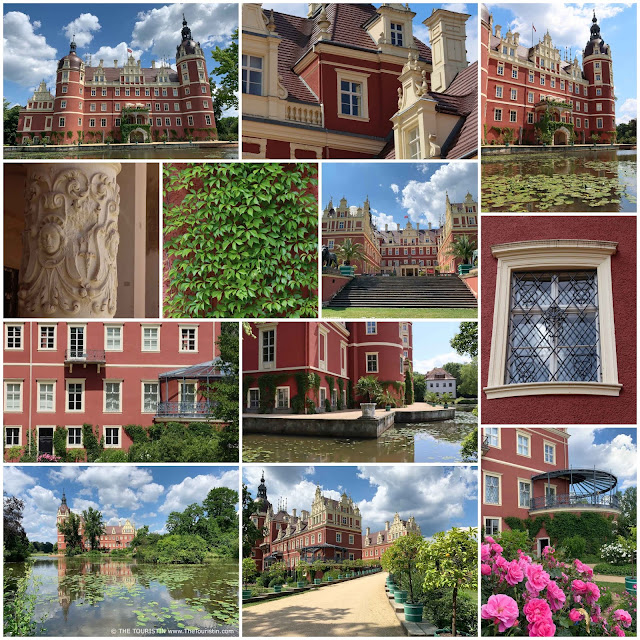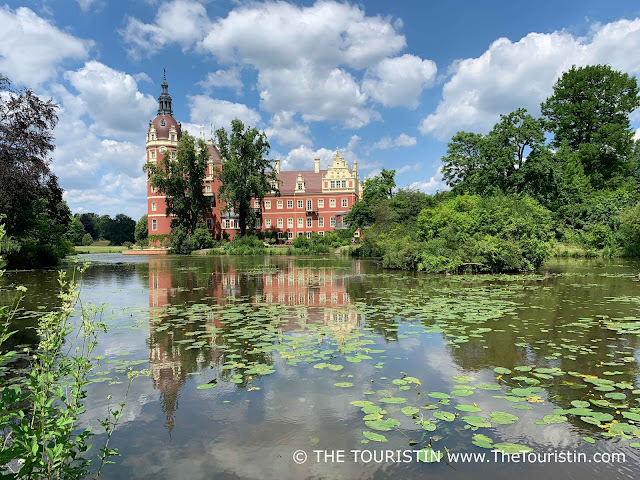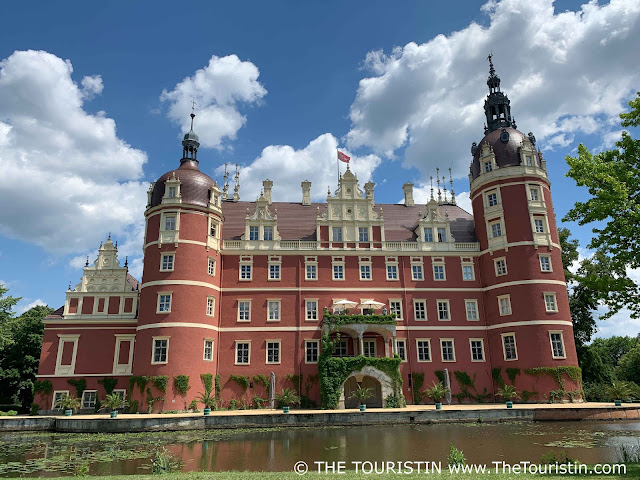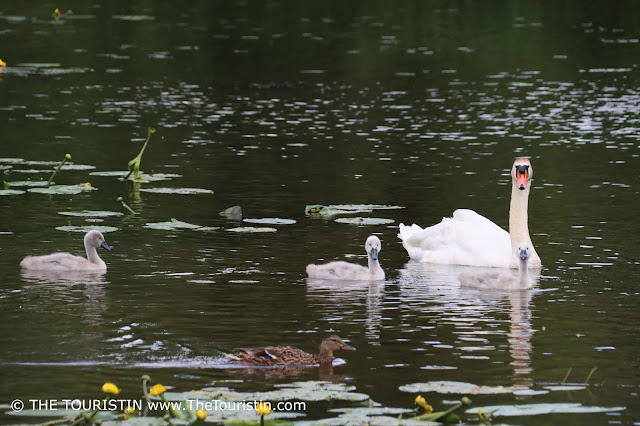This is a story about intercultural projects, heritage, history, gardening, and peace. Europe, that is diverse culture, food, people, and
landscapes. Europe has thousands of towns, places, villages, beaches, and
mountains. One would need a lifetime and more to see all Europe has to offer.
Next time you visit Berlin, take a day to visit a castle in the German state of
Saxony.

The Free State of Saxony in the eastern part of
Germany is surrounded by four German states, by Brandenburg, Saxony-Anhalt,
Thuringia, and Bavaria. Poland and the Czech Republic are just a skip and a
jump away. Bad Muskau, a spa town, is located on the Lusatian Neisse. Muskau
Castle, built in Neo-Renaissance style, in the Fuerst-Pückler-Park in Bad
Muskau is a castle complex in the north of the German state of Saxony. The
river forms the German-Polish border ever since 1945, and the town sits
directly opposite the town of Łęknica in Poland. Within a few moments, you can walk
through the Fuerst-Pueckler-Park Bad Muskau from Germany to Poland. One park,
two countries and one UNESCO World Heritage site? What is not to like?
When you approach Bad Muskau, you will see that you
drive endless kilometres through pine heath, which is shaped by the ice age.
Pines prefer to be at home on sandy soil, and there are sand, heather, and
blueberry everywhere. Not much grows here when there is no rain. And rain is
rather rare in this area.
Fuerst Pueckler Park Bad Muskau, the largest
English-style landscape park in Europe has been awarded UNESCO World Heritage
status as a cross-border cultural landscape in 2004. This park is sure to be
count amongst the most exciting sights to visit in Germany and Poland. The park
has a long history and it is also an intercultural success story. The extensive
grounds of the Muskauer Park with its meadows, bridges and buildings, trees,
lakes, and rivers can easily be explored on an extensive walk. Prince Pueckler,
the creator of the park, is described as one of Germany’s most important
landscape designers. Who was Prince Pueckler, this apparent true star of
landscaping?
Glamour boy, landscape artist, traveller, and dessert
muse
When Hermann Pueckler was born in Muskau Castle in
1785, his mother was only 15 years old. In 1815, he began to create a
landscaped park surrounding the existing Renaissance castle on both sides of
the river Neisse. Pueckler created visual pure lines of sight through
artistically planted trees, carefully placed buildings and by using the
attractive location on the hillside terraces of the valley of the river Neisse.
Here in Lusatia, he created a park the size of 830 soccer fields. Imagine that,
when this park was created in 1815, there was no Poland as we know it today.
Poland was yet to become a sovereign state. The area was divided between
Prussia, Russia, and Austria-Hungary. Today, two-thirds of this park area is on
the Polish territory in Leknica.
Prince Pueckler fled from reality and travelled.
From 1826 to 1829 he studied the creation of English landscape gardens in
England. He planned an America trip and spent six years in the Middle East and
on the African continent. In 1837, Pueckler purchased an Ethiopian 12-year-old girl at the slave market of Cairo. He called her ‘the beloved’ and
took her with him wherever he went. It is outright horrible and appalling to
think of. This was a time when a 50-year-old man could buy a child as a
mistress, pretending to feel nothing but love for her.
Mahbuba, his slave
mistress, died and was buried only three years later in Muskau in 1840. Over
the course of the years, Pueckler ran out of money and got divorced, while hoping
to find another wealthy wife who might fund his project. That vision never
became a reality, and he decided to sell Muskau castle and the park. In 1846, Prince Wilhelm Friedrich Karl von
Oranien-Nassau acquired Muskau domination. Pueckler took the
money moved to the nearby town of Cotbus and created another landscaped garden.
In Germany, Prince Pueckler ist mostly known for a
dessert dish. The recipe was created in 1839 by Louis Ferdinand Jungius, the
head chef of the royal Prussian household. The combination of three different
ice-cream flavours, namely strawberry, vanilla and chocolate ice cream on one
plate (often sandwiched between two light waffles) is named after Pueckler.
Castle Muskau – From fortification to ruin to
fairy-tale castle
The first documented mention of the castle is from
1245. It is believed that there was a water castle until the 15th century when
the complex was extended. In the 16th century, the property turned from
medieval fortification to representative castle. Prince Pueckler planned to
heavily redesign the castle, he removed fortress walls, bridges, and the moat.
As money ran out, the new owner, Prince Wilhelm Friedrich Karl von
Oranien-Nassau took over and rebuild the baroque castle in the neo-renaissance
style.

Muskau Castle burned down in the spring of 1945,
probably due to arson. For decades nothing was done to restore it and its ruin
stood untouched in the park. After the fall of the wall, in November 1989, it was
apparent that culture and history had suffered from neglect in Germany's east.
One might wonder if it was outright ignored by the GDR regime and its fans. No
one had spent much money or effort in restoring historical sites. The German
part of the Fuerst-Pueckler-Park Bad Muskau was awarded heritage status in
1955, the park and its paths and trees and plants were well looked after and
cared for, but that was it.
There were plans to bring Castle Muskau back to its
original glamour. Words are cheap, and as far as historical buildings in the
park are concerned, nothing of relevance was ever created during the time of
the dictatorship of the German Democratic Republic. This can be explained with
a popular joke from GDR times. Question: Is it possible to build a system of
socialism in the desert? Answer: In principle yes. Nothing happens for five
years, but then the country runs out of sand.
45 years of the cold war were over when the regime
of the GDR decided reunification would be a clever thing. After 40 years of
existence, the GDR voted to join West Germany, and out of a sudden, people were
free and could envision the restoration of historical sites. Funding for these
projects became available pretty soon after the end of the GDR. The rebuilding
of Castle Muskau started sort of immediately. A lot was rebuilt in the three
decades since.
Restoration and maintenance projects in the park, the orangery,
the mews, and the new castle started in 1993, and all in compliance with
original plans. I imagine that what we as guests can enjoy today can only be
the result of true passion and love for heritage, history and gardening. The
reconstruction of Bad Muskau castle cost 25 million EUR and was finished as
recently as 2013. Job well done. The result looks as glamorous as can be.
The entire castle complex is made of the new
castle, the old castle, the cavalier's house, the mews, and the orangery. It
has everything a glamorous castle needs: Decorative gables and grilles,
balconies, sculptured figures, lanterns, decorative friezes, and ornamented
round towers. A massive staircase connects the castle with the landscaped park.
Fuerst-Pueckler-Park Bad Muskau - UNESCO World
Heritage status for this cross-border cultural landscape
From 1945 the river Neisse, which runs right
through the park became the dividing line. When the border between the German
Democratic Republic and Poland was drawn after the Second World War in 1945,
Muskau Park became bilateral.
There was a shortage of materials and inadequate
gardening equipment in the GDR. Gardeners were inventive and the landscaped
garden could be preserved thanks to their imagination. On the Polish side,
almost nothing was known about the history of the park until the 1990s. No
path, no footbridge could be seen, all was overgrown. In all the years of the
WW2 and those that followed afterwards, the forest had all the time in the
world to grow that there was no structure of the park left to be seen.
Today, the two countries meet in this World
Heritage Site on the river Neisse. See whether you can locate the border posts
in red and white (Poland) and black, red and gold (Germany) and walk over a
bridge from one embankment to the other within the blink of an eye. Up until
1990, this would not have been possible at all. The border between the GDR and
Poland was strictly protected, it was fenced, secured with infra-red detectors
and guards. Enjoying this truly European moment, I did all the things one would
do. I stood with one foot in Germany and with the other in Poland. I took
photos over the river Neisse from Poland to Germany and also into the other
direction. It is fascinating to experience up close how far Europe has come.



Fuerst-Pueckler-Park Bad Muskau had the luck to
have all these passionate gardeners. German gardeners worked together with
Polish conservationists. Great efforts were made to maintain the park. Now,
Polish and German visitors and tourist groups walk through the park in equal
delight. With combined powers, Germans and Polish people are keeping this late
baroque park alive.
At the end of the 1980s, there was a collaboration with the
Polish park gardeners for the first time. It pretty much all started with an
idea from the Polish and German employment offices in the border region. Their
vision was that a handful of German and Polish unemployed should recover and
rebuild the historical paths in the Polish part of the park. That project
worked out marvellously and exceptionally well, and that against all odds, like
language barriers, different financial- and human resources, and all
differences in behaviours and worldviews. This project is a brilliant example
of how a united Europe works together and achieves amazing things. The
gardeners reconstructed the park fervently and in great detail and in line with
Prince Pueckler's original plans.
Walking through landscape paintings
When you visit Bad Muskau park, you can see gardeners
working seemingly everywhere. They are seriously busy gardening their heart out.
The park otherwise oozes complete calm and quiet. The castle within sight, the
meadows, the 800,000 trees, the ponds, and the small streams, it is so idyllic.
There are views all the way to the horizon. It feels as if you enter a new
painting with every step you take.
Highlights Fuerst-Pueckler-Park Bad Muskau and
Muskau Castle
Worth seeing in the park are: the reconstructed
Castle with the Pueckler exhibition and the castle tower, the Baroque cavalier
house, the orangery as well as the palace garden with a kitchen garden and the
exhibition on pineapple cultivation. Please check opening hours before you visit.
What you need to know to travel to Fuerst-Pueckler-Park Bad Muskau and Muskau Castle
Visa requirements for Germany
You can apply for the German
Schengen Visa, as a Member State of the EU, Germany is a member state of the
Schengen Area. Visitors from the Schengen countries do not need a passport or
visa, only a valid an ID-card or passport. Visit this website to see whether you need a Visa to visit Germany. Please check travel regulations which might be in place because of the
Coronavirus covid19 pandemic.
How to get to Fuerst-Pueckler-Park Bad Muskau and
Muskau Castle
By car. From Berlin and Cottbus, A 15 via the B
115. From Dresden, A4 via the B 156. From Görlitz, B 115. There is a visitor
car park located at one of the entrances of the park. Simply follow the signs
to Fuerst-Pueckler-Park Bad Muskau.
By public transport: Take the train of the
Ostdeutsche Eisenbahn GmbH (ODEG) to Weißwasser. Once there, board the bus 250
to Bad Muskau. Get off at stop "Kirchplatz" and walk a few minutes to
the entrance of the park.
Best time to visit Fuerst-Pueckler-Park Bad Muskau and Muskau Castle
Summers are dry and can be hot with temperatures up
to above 30 degrees Celsius at times. Wear sunscreen. Spring is a pleasant
time, on good days temperatures can go up to 20 degrees Celsius. Autumn is a
colourful time to visit. Winter can be rainy and miserable, with the odd snow
day; on some days, temperatures can fall well below zero degrees Celsius. Wrap
up warm.
Germany – Currency and how to
pay
Germany is a member of the European Union. The
official currency in Germany is the Euro. Exchange money on arrival at the
airport, or get some cash at an ATM. You can pay in cash still almost
everywhere in town (some shops/restaurants/cafes only accept cash though).
Credit cards are hardly, if ever, accepted. The situation might change due to the
coronavirus covid19 epidemic as more and more businesses are asked to accept
cashless payment. Only time will tell if Germans are ready for cashless
payment. Until then, bring cash and be on the safe side.
Info, tickets and hours Fuerst-Pueckler-Park Bad
Muskau and Muskau Castle
Neues Schloss, 02953 Bad Muskau, Germany. Tickets: EUR
8.00. Family ticket EUR 18. The entrance is free for preschool kids (only when
accompanied by an adult). The entrance to Fuerst-Pueckler-Park Bad Muskau is
free. Hours: From June 20, 2020, the New Castle will be open daily from 10am to
6pm.
Accessibility Fuerst-Pueckler-Park Bad Muskau and
Muskau Castle
All rooms of the permanent and special exhibition
in the New Palace are barrier-free. The steps of the castle stairs can be used
with a wheelchair lift. Please press the call button for help. An elevator
takes guests to the first and second floor in the castle building. There is an
accessible toilet on the ground floor. At the nursery, wheelchair users, and
visitors with prams or walkers can press a help button when they would like to
visit the pineapple exhibition and the kitchen garden. The paths of the main
parkland are mostly paved with sand. Please contact administration for detailed
information before your visit. info@muskauer-park.de
Wi-fi and technology in Muskau Park and Muskau Castle
There is no free Wi-Fi
available. Please note that Fuerst-Pueckler-Park Bad Muskau
with its Muskau Castle is a no-drone area.
From Berlin with love























